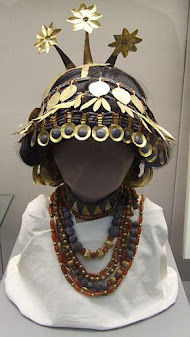History of clothing in Indus Valley Civilization
History of clothing in the Indian subcontinent can be traced to the Indus valley civilization or earlier. Indians have mainly worn clothing made up of locally grown cotton. India was one of the first places where cotton was cultivated and used even as early as 2500 BCE during the Harappan era. The remnants of the ancient Indian clothing can be found in the figurines discovered from the sites near the Indus valley civilization, the rock-cut sculptures, the cave paintings, and human art forms found in temples and monuments. These scriptures view the figures of human wearing clothes which can be wrapped around the body. Taking the instances of the Sari, the bandana, to that of the turban and the dhoti; the traditional Indian wears were mostly tied around the body in various ways.
Statue of the "Priest King" wearing a printed robe, Mohenjo-daro, Indus Valley civilization, c. 2000–1900 BCE.
Royal cemetery of Ur headdress according to some scholars is
a direct import from Indus valley civilization and similar headdress has been
discovered at site of Kunal.
Indus Valley Civilization period
Evidence for textiles in Indus Valley
civilization are not available from preserved textiles but from
impressions made into clay and from preserved pseudomorphs. The
only evidence found for clothing is from iconography and some
unearthed Harappan figurines which are usually unclothed. These little depictions show that usually men
wore a long cloth wrapped over their waist and fastened it at the back (just
like a close clinging dhoti). A turban was worn in some communities as shown by
some of the male figurines. Evidence also shows that there was a tradition of
wearing a long robe over the left shoulder in higher class society to show
their opulence. The normal attire of the women at that time was a skirt up to
knee length, leaving the waist bare. Headdresses were also worn by the women.
Women also wore long skirt,
stitched tight tunic on their upper body and trousers as well. Inferences from
mother goddess statue from Delhi National Museum suggests female
wearing a short tunic with a short skirt and trousers. There also evidences of men wearing trousers,
conical gown/tunic with an upper waist band. The mother goddess statues show
women also wearing heavy earrings which were also pretty common in the historic
period of India and also depict with heavy necklaces with overhanging medallion
with holes in them for gemstones. Female statues and terracotta arts and
figurines like a dancing girl also depict long hair probably braided and draped
in cloth.
Fibre for clothing generally used were cotton, flax,
silk, wool, linen, leather, etc. One fragment of coloured cloth
is available in pieces of evidence which are dyed with red madder show that
people in Harappan civilization dyed their cotton clothes with a
range of colours.
Both sexes wore jewellery. The ornaments include necklaces,
bracelets, earrings, anklet, rings, bangles, pectorals, etc. which were
generally made of gold, silver, copper, stones like lapis lazuli, turquoise, amazonite, quartz,
etc. Many of the male figurines also have their hair dressed in various styles
like the hair woven into a booty, hair coiled in a ring on the top of the head,
beards were usually trimmed. Indus Valley Civilization men are frequently
depicted wearing headbands especially to contain hair bun at the back. People
have been shown wearing elaborate headdresses like turban, conical hats, pakol hats.
Dressing of Indus valley civilization people show presence
of multi-ethnic people of diverse backgrounds for instance people have been
depicted wearing Pashtun style pakol hat with a chocker like neck ornament as
well as Punjabi style pagri and Rajasthani style bangles and
necklaces and many other styles prominent in neighbouring regions of the Indian
subcontinent.
Some scholars, such as Jonathan Mark Kenoyer, have
argued that headdress from the royal cemetery of Ur is an import from Indus
Valley Civilization since similar headdresses have been found to have been
depicted in many of its Mother Goddess figurines and actual
ones discovered from sites such as Kunal and the floral depiction in
gold leaves of species native to Indian subcontinent such as Dalbergia
sissoo or pipal, and since no such ornamentation has been shown in
Mesopotamian art itself.




Comments
Post a Comment